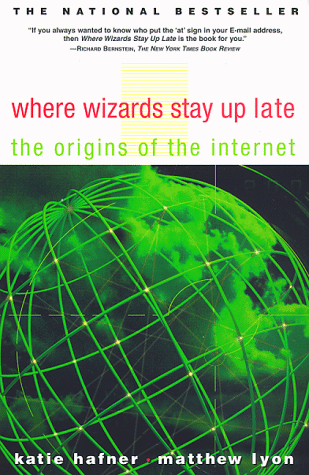w h e r e w i z a r d s s t a y u p l a t e -=-=-=-=-=-=-=-=-=-=-=-=-=-=-=-=-=-=-=-=-=-=-=-=-=-=-=-=-=-=-=-=-=-=-=-=-=-=- by Katie Hafner and Matthew Lyon ISBN: 0-684-83267-4 * Simon & Schuster, 1996 * $13.00

w h e r e w i z a r d s s t a y u p l a t e -=-=-=-=-=-=-=-=-=-=-=-=-=-=-=-=-=-=-=-=-=-=-=-=-=-=-=-=-=-=-=-=-=-=-=-=-=-=- by Katie Hafner and Matthew Lyon ISBN: 0-684-83267-4 * Simon & Schuster, 1996 * $13.00


Thirty years ago, interactive computer networks did not exist anywhere -- except in the minds of a handful of computer scientists. In 1966, the Defense Department's Advanced Research Projects Agency funded a project to create computer communication among its university-based researchers. The experiment was inspired by J.C.R. Licklider, a brilliant research scientist from MIT, and Robert Taylor, the Director of the ARPA office that funded it. At a time when computers were generally regarded as nothing more than giant calculators, Licklider and Taylor saw their potential as communications devices. "Where Wizards Stay Up Late" is the story of the small group of researchers and engineers whose invention, daring in its day, became the foundation for the Internet. With ARPA's backing the quest for a way to connect computers across the country began.
Read an excerpt : the History of Email
In 1969, ARPA awarded the contract to build the most integral piece of this network -- a computerized switch called the Interface Message Processor, or IMP -- to Bolt Beranek and Newman (BBN), a small Cambridge, Massachusetts company. A half-dozen engineers at BBN, who called themselves the IMP Guys, knew it was possible to do what larger companies -- including AT&T and IBM -- had dismissed as impossible. But making computer networking possible required inventing new technologies. Working around the clock, the IMP Guys met a tight deadline, and the first IMP was installed at UCLA nine months after the contract award. A nationwide network called the ARPANET grew from four initial sites. Protocols were developed, and along the way a series of accidental discoveries were made, not the least of which was e-mail. Almost immediately, e-mail became the most popular feature of the Net and the "@" sign became lodged in the iconography of our times. The ARPANET continued to grow, then merged with other computer networks to become today's Internet. In 1990, the ARPANET itself was shut down, fully merged by then with the Internet it had spawned. "Where Wizards Stay Up Late" tells the fascinating story of a group of young computer whizzes with a common vision who succeeded where others had refused even to venture. In the process, they invented the most important communications medium since the telephone.
-=-=-=-=-=-=-=-=-=-.Bios.-=-=-=-=-=-=-=-=-=-=-
Katie Hafner is a contributing editor at "Newsweek," covering technology, and is the coauthor of "Cyberpunk: Outlaws and Hackers on the Computer Frontier."Matthew Lyon is Assistant to the President of the University of Texas at Austin and a former associate editor of "The Texas Observer."
They are married and live in Sonoma, California.
-=-=-=-=-=-=-=-=-.Reviews.-=-=-=-=-=-=-=-=-=-=-
FringeWare Review
NYTimes review by Richard Bernstein.
Washington Post review by John Schwartz
The Internet: What a Mesh! by Mark Baechtel
-=-=-=-=-=-=-=-=-=-.Blurbs.-=-=-=-=-=-=-=-=-=-=-
"This is the way a world begins: distributed engineering. What a creation story it is, here fully told for the first time...To a current Net denizen it's like discovering that mountains, oceans, weather, fire, and gravity were each once somebody's bright idea."
--Stewart Brand, Editor of the Whole Earth Catalog"Not only wizards but anyone interested in the most exciting new medium of our time will stay up late reading Katie Hafner and Matthew Lyon's lively and important history of the Internet."
--Steven Levy, Author of Hackers: Heroes of the Computer Revolution"At last, an engaging and authoritative history of the Net, compellingly told. Where Wizards Stay Up Late will delight anyone curious about the Internet's origins. Even if you care only about the Net's future, read this book for the vital context it provides."
--Paul Saffo, Director, Institute for the Future"Katie Hafner and Matt Lyon have done a real service to the computer community by conveying the sober and accurate truth about Internet history. The reality is even weirder than the myths."
--Bruce Sterling, Author of The Hacker Crackdown: Law and Disorder on the Electronic Frontier
........................................................... =+=+=+=+=+=+=+=+=+=+=+=+=+=+=+=+=+=+=+=+=+=+=+=+=+=+=+=+=+= . where wizards stay up late... the machine shop . . . . pioneers of the net * maps * links * home . ........................................................... =+=+=+=+=+=+=+=+=+=+=+=+=+=+=+=+=+=+=+=+=+=+=+=+=+=+=+=+=+=